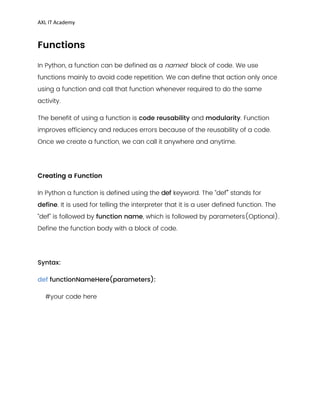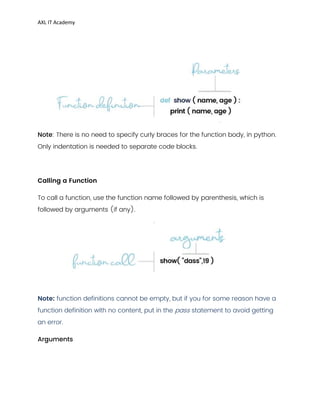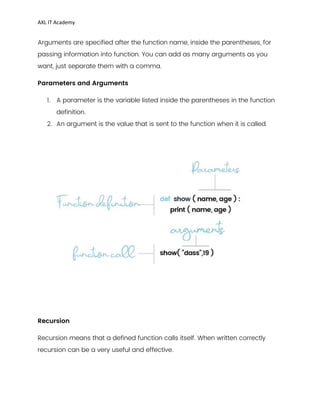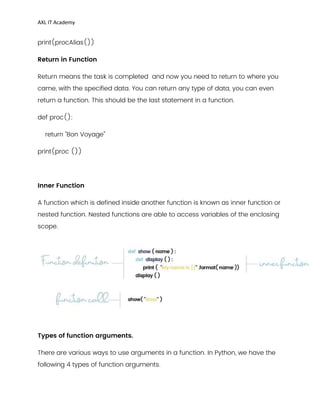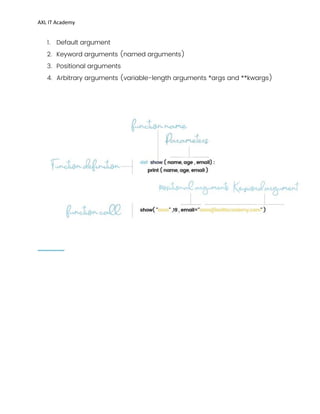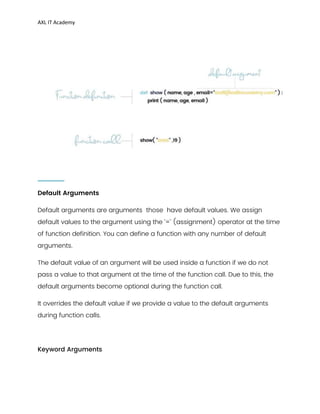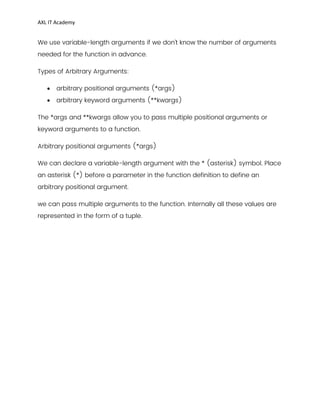functionnotes.pdf
- 1. AXL IT Academy Functions In Python, a function can be defined as a named block of code. We use functions mainly to avoid code repetition. We can define that action only once using a function and call that function whenever required to do the same activity. The benefit of using a function is code reusability and modularity. Function improves efficiency and reduces errors because of the reusability of a code. Once we create a function, we can call it anywhere and anytime. Creating a Function In Python a function is defined using the def keyword. The ŌĆ£defŌĆØ stands for define. It is used for telling the interpreter that it is a user defined function. The ŌĆ£defŌĆØ is followed by function name, which is followed by parameters(Optional). Define the function body with a block of code. Syntax: functionNameHere(parameters): def #your code here
- 2. AXL IT Academy Note: There is no need to specify curly braces for the function body, in python. Only indentation is needed to separate code blocks. Calling a Function To call a function, use the function name followed by parenthesis, which is followed by arguments (if any). : Note function definitions cannot be empty, but if you for some reason have a function definition with no content, put in the pass statement to avoid getting an error. Arguments
- 3. AXL IT Academy Arguments are specified after the function name, inside the parentheses, for passing information into function. You can add as many arguments as you want, just separate them with a comma. Parameters and Arguments 1. A parameter is the variable listed inside the parentheses in the function definition. 2. An argument is the value that is sent to the function when it is called. Recursion Recursion means that a defined function calls itself. When written correctly recursion can be a very useful and effective.
- 4. AXL IT Academy Example: #Recursion function which prints upto 99 without for/while recur (k): def if(k <100): (k) print k+=1 ( k ) recur #calling recur recur (1) Function Assignment We can assign a function to a variable in the same way as we assign a value to it. You can even use those variables to call the function as well. def proc(): return "Welcome" procAlias= proc print(proc) print(procAlias) print(proc ())
- 5. AXL IT Academy print(procAlias()) Return in Function Return means the task is completed and now you need to return to where you came, with the specified data. You can return any type of data, you can even return a function. This should be the last statement in a function. def proc(): return "Bon Voyage" print(proc ()) Inner Function A function which is defined inside another function is known as inner function or nested function. Nested functions are able to access variables of the enclosing scope. Types of function arguments. There are various ways to use arguments in a function. In Python, we have the following 4 types of function arguments.
- 6. AXL IT Academy 1. Default argument 2. Keyword arguments (named arguments) 3. Positional arguments 4. Arbitrary arguments (variable-length arguments *args and **kwargs)
- 7. AXL IT Academy Default Arguments Default arguments are arguments those have default values. We assign default values to the argument using the ŌĆś=ŌĆÖ (assignment) operator at the time of function definition. You can define a function with any number of default arguments. The default value of an argument will be used inside a function if we do not pass a value to that argument at the time of the function call. Due to this, the default arguments become optional during the function call. It overrides the default value if we provide a value to the default arguments during function calls. Keyword Arguments
- 8. AXL IT Academy Usually, at the time of the function call, values get assigned to the arguments according to their position. So we must pass values in the same sequence defined in a function definition. For example, when we call show('dass', 19), the value ŌĆ£dassŌĆØ gets assigned to the argument name, and similarly, 19 to age and so on as per the sequence. We can alter this behavior using a keyword argument. Keyword arguments are those arguments where values get assigned to the arguments by their keyword (name) when the function is called. It is preceded by the variable name and an (=) assignment operator. The Keyword Argument is also called a named argument. Change the sequence of keyword arguments Also, you can change the sequence of keyword arguments by using their name in function calls. Python allows functions to be called using keyword arguments. But all the keyword arguments should match the parameters in the function definition. When we call functions in this way, the order (position) of the arguments can be changed. Positional Arguments Positional arguments are arguments that can be called by their position in the function definition By default, Python functions are called using the positional arguments. Variable-length arguments
- 9. AXL IT Academy We use variable-length arguments if we donŌĆÖt know the number of arguments needed for the function in advance. Types of Arbitrary Arguments: ’éĘ arbitrary positional arguments (*args) ’éĘ arbitrary keyword arguments (**kwargs) The *args and **kwargs allow you to pass multiple positional arguments or keyword arguments to a function. Arbitrary positional arguments (*args) We can declare a variable-length argument with the * (asterisk) symbol. Place an asterisk (*) before a parameter in the function definition to define an arbitrary positional argument. we can pass multiple arguments to the function. Internally all these values are represented in the form of a tuple.

